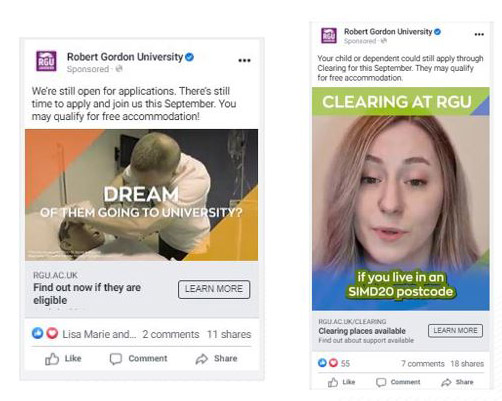RGU
Widening access to Higher Education for the underprivileged in Scotland
When attempting to fill positions during Clearing, Robert Gordon University (RGU) went the extra mile to promote equality, showcasing how it can be done successfully. They acknowledged that some students face inequalities when accessing higher education, so a portion of RGU’s Clearing budget focused on reaching these prospective, first‐generation students in the most deprived areas of Scotland.
By targeting SIMD20 (Scottish Index of Multiple Deprivation) postcodes and overlaying this with demographic and behavioural data, RGU was able to run tailored messaging to this audience. Google and Facebook were used to speak directly to this audience and their parents. This strategy promoted accommodation offers that this audience may have been eligible for, as well as reassurance that all applications were given equal consideration.

What was the challenge?
RGU were trying to reach a small audience with very nuanced and specific needs. Certain messages were needed to be communicated to this audience in a concise and non‐patronising way. They also needed to reach a very varied audience, talking to both students and their parents.
What was our solution?
Our team’s media strategy went live across SIMD20 postcodes, which is how the Scottish government identify areas of deprivation. This way, we were able to direct our activity at the location in which our target audience was more likely to reside in.
In the messaging, the background of this audience wasn’t mentioned, rather solutions and opportunities were simply highlighted. For example, across Google we didn’t include keywords such as ‘low‐income background’, we just replicated the same keywords used across their main Clearing campaign, but only targeted certain postcodes. Across Facebook, accommodation offers were promoted, but it also asked the audience to check their eligibility, rather than pointing out the ways in which they might be eligible. RGU will also be receiving funding to help accommodate students from these particular postcodes.

What were the results?
A very cost‐efficient CPA (Cost Per Action) of £32 (168 acquisitions) was secured.
What’s next?
UCAS’s recent end‐of‐cycle report showed that the number of students going to higher education from the country’s lowest‐participation neighbourhoods has increased by more than 50% since 2013. There has been a lot of work done over the past decade to improve widening access across higher education and it is hard to know what has worked and what hasn’t. However, with the cost‐of‐living crisis deepening and university offers becoming more competitive, a focus on widening access needs to continue. The messaging needs continuous evaluation, and it needs to go further than targeting postcodes.
